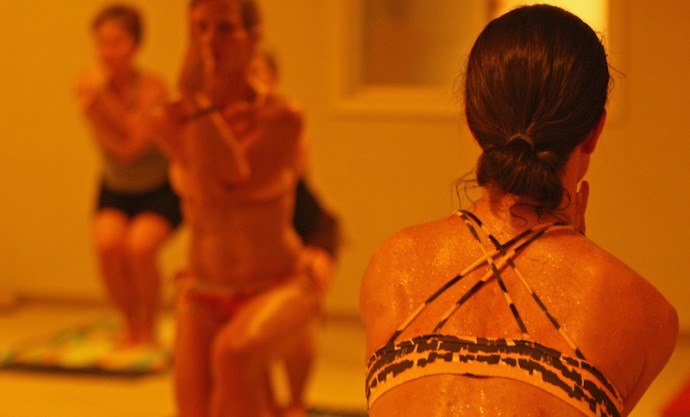Be afraid. Yoga isn’t just about physical fitness and reduced stress. Evangelical leaders are increasingly warning that yoga is religious, though not in a good way, and that Christians must choose between Christianity and yoga. This view shot to mainstream attention recently when Albert Mohler, president of the Southern Baptist Theological Seminary, warned Christians against the sin of yoga in a blog post that made headlines. But his comments were far from an isolated incident of evangelical Christian leaders inciting fear of yoga; Mohler simply took his place among the growing ranks of twenty-first century conservative Christian leaders with “yogaphobia.”
Since 2001, Laurette Willis, a public speaker and fitness trainer, has actively warned fellow Christians about the religious peril of the nation’s fastest growing method of exercise while promoting a “Christian alternative to yoga,” which she calls PraiseMoves. In a 2005 article in Today’s Christian Woman ominously titled “The Truth About Yoga,” Holly Vicente Robaina recounts Willis’ cautionary tale of how yoga led her into a life of errant New Age practices, loneliness, alcoholism, and promiscuity. After years of pain, she discovered Christianity, burned her New Age books, and gave up yoga. In a follow-upChristianity Today article titled “Take a Pass on Yoga” Robaina tells her own story of being seduced by yoga, along with numerous other destructive New Age practices, and the years it took for her to give them up for Christianity.
Twenty-first century yogaphobia has only gained momentum. In a 2007 interview on CNN, John MacArthur, pastor of Grace Community Church in Sun Valley, California, warned Christians against doing yoga, referring to it as a “false religion.” At around the same time Pat Robertson issued a similar warning describing some aspects of it as “really spooky.” Even more recently Mark Driscoll, pastor of Mars Hill Church in Seattle, Washington, told a live audience that: “Yoga is demonic… It’s absolute paganism… Yoga and meditation and Easternism is [sic] all opening to demonism… if you just sign up for a little yoga class, you’re signing up for a little demon class. That’s what you’re doing. And Satan doesn’t care if you stretch as long as you go to hell.”
Similar to Islamophobic attempts to produce and demonize a monolithic vision of Islam, Mohler’s recent post simplifies and flattens yoga. In particular he’s bothered by the fact that yoga is grounded in the belief that the body is a means to experience the divine; Christians, according to Mohler, should only rely on biblical scripture as a means to understanding God. “When Christians practice yoga,” he writes, “they must either deny the reality of what yoga represents or fail to see the contradictions between their Christian commitments and their embrace of yoga. The contradictions are not few, nor are they peripheral.” Yoga, in other words, is not compatible with Christianity.
And whether it’s Christians against non-Christians or Americans against non-Americans what it boils down to is, “you’re either with us or against us”—a strategy with nationalist dimensions. And sure enough, for Mohler and other evangelical opponents of yoga, part of the problem is that it comes from India. In discussing yoga’s roots in India, he characterizes it as “almost manically syncretistic.” Mohler warns that if that syncretism is allowed to further infect the United States, we will end up living in the unthinkable: a “post-Christian” nation.
But this attempt to produce a monolithic vision of yoga ignores the fact that it, like religion itself, is anything but a stable phenomenon. Yoga has a long history whereby adherents of numerous religions, including Hindu, Jain, and New Age traditions, have constructed and reconstructed it anew. Even Hindu forms of yoga vary widely in ideology and practice. Thus yoga does not belong to Hinduism nor any other monolithic tradition.
But evangelical Christians have an odd bedfellow in the argument for a monolithic vision of yoga as Hindu: some Hindus. They reflect the same ahistorical, religiously fundamentalist tendencies, but with an entirely different agenda. The two agree that yoga is Hindu and that its global popularity is a bad thing. But rather than argue that yoga’s popularity is bad because it is incompatible with Christianity, they claim that non-Hindu yogis fail to give Hinduism credit for being the tradition from which yoga arose.
In his recent Washington Post commentary, “The Theft of Yoga,” Aseem Shukla, Associate Professor of urologic surgery at the University of Minnesota medical school and co-founder and board member of the Hindu American Foundation, goes so far as to argue that yoga is the “intellectual property” of Hinduism and that it is “a victim of overt intellectual property theft [and the] absence of trademark protections.” He goes on to criticize the “crass commercialism” of yoga in the United States; which I find particularly problematic since I cannot imagine a more explicit commercialization of yoga than that found in his own argument that yoga is a stable identifiable product invented by a monolithic tradition, that it is the property of that tradition, and that it needs to be protected by trademark laws. Shukla is not alone in his Hindu criticism of non-Hindus practicing yoga. The Hindu American Foundation shares Shukla’s concern that yoga has been stolen from Hinduism and has published its own statement that supports this view.
Both the evangelical Christian yogaphobic position and the Hindu essentialist yoga-belongs-to-Hinduism position reflect religious fundamentalist tendencies to define ideas and practices not as human constructs that are subject to change over time, but as monolithic stable products that belong in specific traditions and accordingly do not belong in others.
Despite his ahistorical view of yoga, Mohler is right about two things. First, the question of whether or not Christians should practice yoga does betray something about our current cultural moment. For Mohler, that something is that conceptions of the body and self in yoga advance the development of a post-Christian United States, something we should fear. I would argue, however, that what we learn is not about ancient or classical Christian or yoga conceptions of the body and self, but rather about conceptions of the body and self that already dominate our contemporary cultural context.
In fact, what scholars of yoga today often refer to as “modern yoga,” a pop-culture movement that in many forms competes in the fitness and health global market, has more in common with contemporary consumer culture than with ancient and classical schools of yoga. One feature of consumer culture is that we increasingly have choices when it comes to the ideas and practices we adopt. We choose ideas and practices much like we choose commodities. Consumers choose from a variety of yoga forms that serve to enhance their bodies and selves in ways that suit their particular desires and needs.
Mohler was also correct in noting that yoga is religious. Just because proponents of modern yoga compete in a market in which consumers choose ideas and practices much like they might choose a car doesn’t mean that modern yoga isn’t religious. In fact, modern yoga has everything to do with the sacred. Modern yoga’s sacralization of the body makes it not just compatible with, but largely a product of, the metaphysical conceptions underlying contemporary consumer culture. Since modern yoga features a metaphysical approach to the body that treats it as part of the self, it is not a coincidence that it has increasingly attained global popularity in the consumer culture that flourished in the second half of the twentieth century.
In this new phase of capitalism, the attainment of physical fitness transcends the mere exchange of capital for material goods. Physical fitness is sacred. Modern yoga fits right in with this socio-historical context. In other words, modern yoga is a reflection, not of “spooky” Hindu gods or “demonic” practices, but of our contemporary culture’s tendency to envelope physical fitness into the sacred routine of self-development.
“There is nothing wrong with physical exercise, and yoga positions in themselves are not the main issue,” according to Mohler, a position that is consistent with that of other evangelical opponents of yoga. Pat Robertson encourages Christians to engage in non-yoga stretching and Mark Driscoll follows his statement that yoga is demonic by noting the value of stretching and exercise and that these things can even be “biblical.” Some Christians come up with religiously Christian fitness “alternatives” to yoga (like Laurette Willis’ PraiseMoves, mentioned above), while other Christians, rather than demonize yoga entirely, have constructed schools of yoga that are identifiably Christian. In picking and choosing the less-threatening aspects of yoga—as well as assuming the value, even sanctity, of physical fitness—evangelical Christians participate alongside modern yogis in the current cultural moment.
Contrary to Mohler’s pronouncements many of us privilege a pluralist view of the United States and resist attempts to construct it as an intolerant Christian country. In addition, his fear of a post-Christian country assumes that the United States has its origins in Christianity; an assumption that is just as historically problematic as arguing that yoga has its origins in Hinduism and thus belongs to it.
If anything should terrify us, it should be the fact that some conservative evangelicals are increasingly opposing a vision of this nation that embraces difference and variety. Because of yoga’s cultural history in India and the religious traditions that emerged there, it is perceived as an encroachment on a conservative vision of a monolithic, white, Christian America. And it fits right in with the growing Islamophobia, a religious and political movement with racist dimensions.
The fact that he brings up Michelle Obama’s choice to add yoga to the events at the annual White House Easter Egg Roll (associating the Obama administration with the post-Christian country he so fears) confirms that Mohler’s yogaphobia is one symptom of a larger political movement to construct the United States as a “Christian nation.” Many of those same players participate in the Islamophobic smears that Obama is secretly Muslim and even anti-Christian. Yoga is perceived as just one more symptom that our (conservative, white) Christian nation is in decline. Put simply, Mohler’s yogaphobia is not an isolated incident of religious exclusivism, but a part of a much larger movement in the United States that thrives on fear of the other.
So will we see the ritual burning of yoga mats anytime soon? I suspect not. But I do sadly expect that the yogaphobic rhetoric will last as long as the fearful religious and political movement for a monolithic country continues to thrive.





